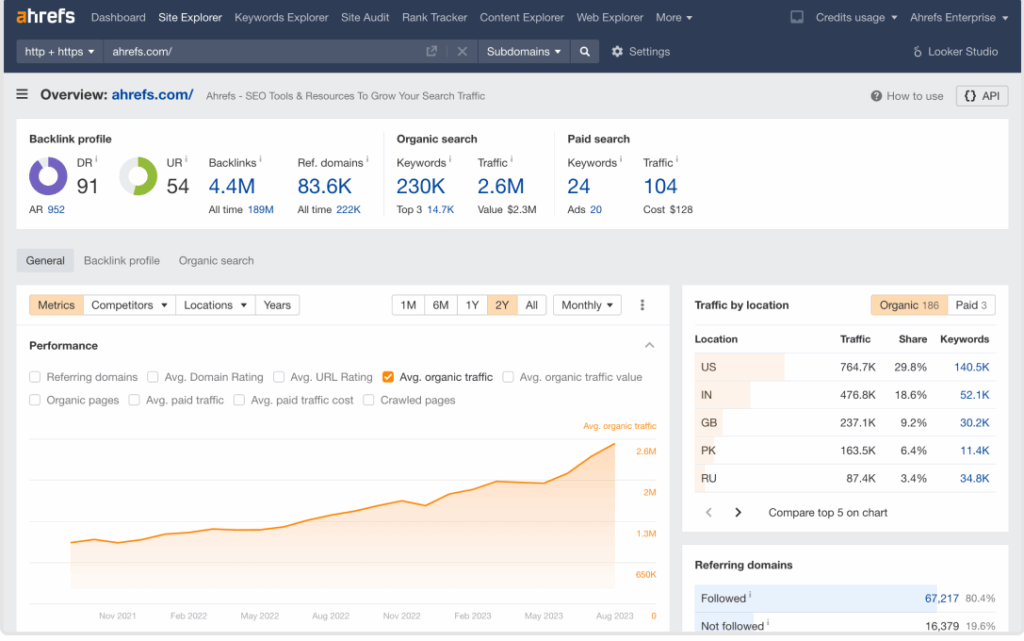
Link Reclamation: Reclaim What’s Yours & Rank Higher
You hustle for weeks (maybe even years) to land those golden backlinks. You snag a powerful DR 80 gem and think you’ve cracked the SEO jackpot…
Then poof! Months later, the backlink is gone like it never existed.
That’s more than just a digital disappearing act. It’s:
- 🔻 Lost traffic
- 📉 Dropped rankings
- 💸 Revenue slipping through your fingers
But hey, here’s where things get exciting… Link reclamation is your secret weapon to flip the script! No extra content, no more cold emails, no paying to play.
Just raw, no-fluff recovery of link juice you already earned.
💣 Pro Tip: Link reclamation is like SEO cashback. You’ve “paid” with time or effort already, now it’s time to collect the dividends.
Here’s the kicker: You’re not begging for attention. You’ve already been linked to! That’s proof that your content mattered once. Reclaiming that lost link? Way easier than starting from scratch.
In this guide, we’ll break it all down:
- How to track down those vanished backlinks
- How to filter the ones that actually matter
- And how to reclaim them without chasing vanity metrics
Ready to claw back what’s rightfully yours with Link Juice Club? Let’s go get it!
What Link Reclamation Really Means
Link reclamation is all about tracking down backlinks that once helped your site thrive but have since gone silent.
We’re talking about the good stuff gone missing. The links that:
- Used to lead to your pages but now hit a dead end
- Got lost in messy redirect chains
- Were removed after a site update or redesign
- Point to outdated content that no longer serves its purpose
Each one of those is a missed opportunity. Even worse, losing backlinks over time creates signals that search engines can misread. Instead of seeing a healthy link profile, the algorithm might start pulling you down the ranks.
Why Lost Backlinks Hurt More Than You Think
Every time a quality backlink disappears, it’s like pulling bricks out of your SEO foundation. Bit by bit, the whole structure weakens and your rankings start to crumble.
Think of it like watering a plant for months only to rip it out just as it’s about to bloom. All that time, strategy, and effort? Wasted.
Here’s why reclaiming those links is more than just a tidy-up:
1. Authority Is Dripping Out the Sides
Every lost link leaks influence.
It’s not just one page that suffers, your whole domain starts feeling the drain. That top-performing money page? It doesn’t stand a chance when its support beams vanish.
✅ Step Confirmation: Reclaiming even a few powerful links can bring that equity roaring back.
2. Rankings Don’t Crash — They Slide
You don’t fall from the rankings, you moreso glide down quietly, like a sled on ice.
One week you’re basking in top-three glory. Then out of nowhere, you’re waving from page two, wondering what happened.
💣 Pro Tip: Google doesn’t send warnings when it re-crawls a lost link. It just adjusts the scoreboard.
3. Google Remembers Everything
Search engines are not sentimental, sadly so.
They recognize patterns of erosion. If they see links disappearing from credible sources with no replacements, they start to question whether your content still holds value.
🚫 Common Mistake: Ignoring link loss makes your site look outdated, even if your content is top-notch.
4. Your Past Content Still Has Firepower
That killer case study, blog post, or tool page you poured hours into?
It’s not dead. It’s dormant. One reclaimed backlink from a heavyweight site can wake it up and send it climbing again faster than you can launch a new batch.
💣 Pro Tip: Reclaiming is like flipping the “ranking” switch back on without lifting a creative finger.
5. Your Rivals Are Sleeping on This
Most SEOs? They chase shiny new links. They forget the old ones ever existed.
That’s your advantage. While they’re busy reinventing the wheel, you’re out here picking gold from your own backyard.
✅ Step Confirmation: Link reclamation is the SEO cheat code no one talks about, especially valuable for client projects where results speak louder than strategy decks.

The Art of Reclaiming Lost Links (Without the Stress)
Forget the over-complication. Reclamation doesn’t have to feel like dissecting a rocket. This is a simple, strategic sweep and when done right, it brings real SEO gains with almost zero new effort.
Let’s break it down.
Step 1: Dig Up the Ghosts
Start with Ahrefs Site Explorer. Enter your website URL and head over to the Backlink section via the main profile menu.
Boom. What you see is your personal backlink graveyard, the links that once lifted your site but have now gone silent.
Step 2: Cut the Noise
Not every link deserves resurrection. Your job is to separate the gold from the gravel.
Use these filters to narrow it down:
- Link type: “Dofollow” only
- Domain Rating: 50+ (go lower for niche-relevant gems)
- Link placement: “Content” or “Text” only
- Lost reason: Pages that throw a 404 error, show missing content, or were taken down

✅ Step Confirmation: You’re now looking at the links that in fact do move the needle.
Step 3: Map the Damage
Now check where those lost links used to point. Check the following:
- Does that site still exist?
- Was it deleted or moved?
- Is there a newer, better destination?
Nine times out of ten, the issue is a broken URL, outdated slug, or a content shift that never got a redirect.
Build a two-column hitlist like this:
| Original Link Location | Updated Target URL |
| [Referring Page URL] | [Correct Destination URL] |
💣 Pro Tip: Keep it lean. Focus on URLs with SEO value, not random old blog posts.
Step 4: Choose Your Fix
There are two cleanup paths, depending on the cause.
Internal Errors (your side messed up):
- Redirect the outdated URL to the new destination using a 301
- Or, bring the original page back to life if it still holds value
External Changes (their side broke the link):
- Contact the webmaster and request a simple link fix
- Keep it friendly, make it effortless, and hand them anything they might need
🚫 Common Mistake: Don’t waste time chasing no-DR junk or dead forums from 2014. Prioritize what matters.
Step 5: Email That Doesn’t Suck
Here’s a message that lands softly but gets results:
Subject: Quick Fix for a Broken Link You Used
Hey [Name],
Hope you’re having a great week. I noticed your article ([Referring Page URL]) used to link to our guide on [Topic], but it looks like the page moved.
Here’s the new, updated link:
[Correct URL]
Feel free to update it so your readers can still access the good stuff.
Really appreciate the original mention. Let me know if there’s anything I can do to return the favor.
Best,
[Your Name]
[Your Website]
Step 6: Follow Up, Don’t Stalk
💣 Pro Tip: Don’t drag it out like a Sunday service. Nobody wants an SEO sermon in their inbox.
Wait 5 to 7 days. No reply? Send a single follow-up.
Something simple like:
Just checking in – no worries if this got buried. Happy to make the fix even easier if needed. Thanks again!
✅ Step Confirmation: One ping. No guilt. No drama.
Step 7: Log Your Wins Like a Pro
Reclaiming is only half the game, while tracking keeps it all sharp. Keep a sheet with:
- Referring domain
- URL linked from
- Anchor text
- Date reclaimed
- Target page
- Status: “Redirected” / “Updated” / “Reinstated”
💣 Pro Tip: Over time, this gives you powerful data on what types of links tend to vanish and more importantly – how to future-proof your campaigns.
Ready to make lost links work for you again? This is how you reclaim your ranking ground and bring your past efforts roaring back to life. No fluff. Just wins.
Making Link Recovery Scalable and Simple
Once you’ve cracked the basics, link reclamation stops being a chore and starts becoming a scalable SEO power play. When you’re handling multiple sites or managing a client roster, the secret is to build a sleek system that hums quietly in the background, catching drops, restoring equity, and pushing performance forward.
Here’s a simple way to scale this like a strategist, not a spammer:
Automate Like a Machine, Think Like a Human
Manual checks? Outdated. Set up automated alerts to do the dirty work for you:
- Open Ahrefs, click on Alerts, hit ‘New Alert,’ and choose the Backlinks option
- Pick the domain you want to monitor and activate alerts for dropped links
- Schedule it for weekly delivery straight to your inbox
No more logins just to play digital detective. Let the data come to you. For those managing multiple brands or clients, upgrade your toolkit:
- SEMrush or Moz Pro to manage multiple profiles
- Little Warden to monitor redirects and page errors without lifting a finger
Make Link Reclamation Part of Your Site’s Foundation
Think of this as link loss prevention because fixing it later is twice the work. Here’s your SEO hygiene checklist:
- Use clean, permanent URL slugs from the start
- Always apply 301 redirects when moving or merging content
- Internally link using final URLs, not staging or draft versions
- Before deleting any page, check if it’s wearing a backlink crown
ROI Over Vanity: Reclaim With Purpose
A high DR backlink that brings zero clicks? Not worth your inbox real estate. Instead, ask:
- Is the referring page actually getting traffic?
- Is the link contextually aligned with your niche or content?
- Is it pointing to a revenue-driving page, or just a dusty blog archive?
- Is the link placed within the content, or buried in the footer?
Pitfalls That Kill Momentum (And Credibility)
Some reclamation plays backfire. Don’t fall into these traps:
- Nofollow noise: Ignore links marked as nofollow from day one unless they actually brought in real visitors
- Toxic domains: If the site’s a minefield of spammy content, leave that backlink in the past
- Lazy redirects: Only point lost links to your homepage if the content actually fits the context
Reclaim in Layers: Don’t Stop at the Root
You’ve probably got second-tier content out there like guest posts, Web 2.0s, niche edits that are quietly doing support work for your main pages.
Reclaiming doesn’t end with your root domain. Go deeper:
- Check if those support pages lost backlinks of their own
- Reclaim them, then use internal links to channel the juice to your money pages
Scaling link reclamation isn’t about doing more. It’s about doing it smarter. With automation, strategic filters, and the courage to skip what doesn’t matter, you’re reclaiming control.

Master the Lost Link Comeback: A Smarter Way to Rebuild Without Starting Over
Reclaiming lost links isn’t about heroics. It’s about leverage. You already earned the mentions, built the authority, and planted the seeds. Link reclamation just lets you harvest what’s already yours but with precision, not pressure.
But let’s be real: going overboard and flooding inboxes with cold requests for forgotten blog posts from 2019 won’t make you a link building genius. It’ll make you look desperate.
Here’s the golden rule: if the link doesn’t move rankings, traffic, or revenue, let it go.
Link reclamation is a long-term asset play, not a quick win tactic. And when you bake it in your SEO system, it becomes one of the highest return, lowest lift activities you can deploy.
💣 Pro Tip: At Link Juice Club, we see this all the time, clients reclaim five to ten high-quality backlinks and watch their rankings rebound, without writing a single word of new content.
So don’t just build links. Rebuild them better. Your reclamation routine should look something like this:
- Quarterly: Run a backlink audit
- Monthly: Reclaim key links and apply redirects
- Weekly: Monitor alerts and flag high-priority losses
- Ongoing: Bake link integrity into content and URL strategy
While others focus only on what’s new, you’ll be building quietly, strategically, reclaiming strength, not begging for it.





